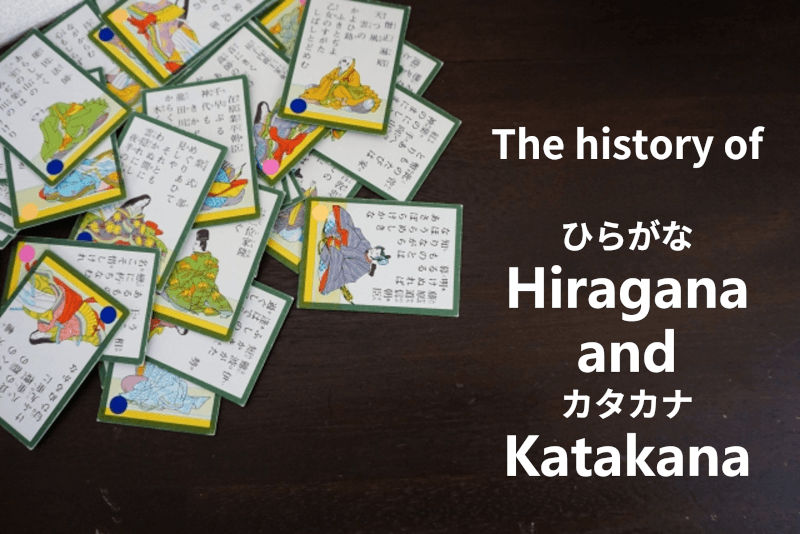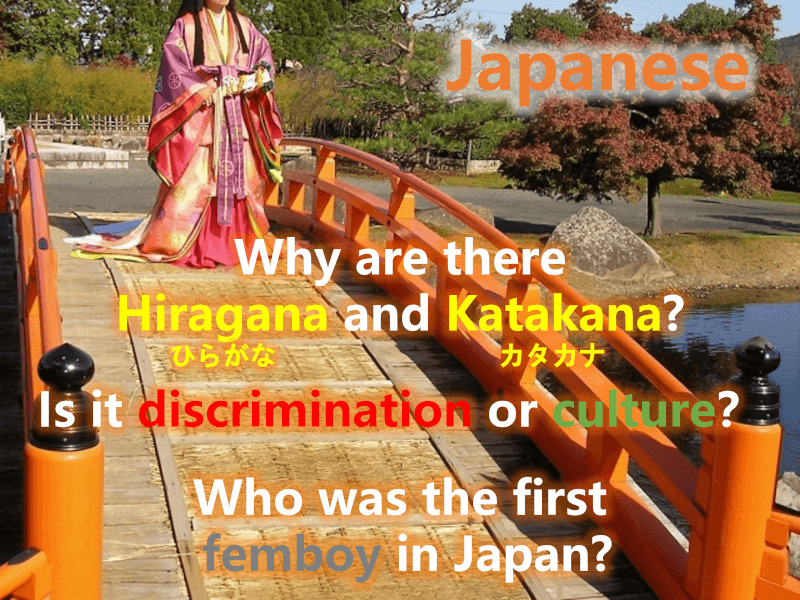Click here for the Chinese version
点击这里并查看中文版本
Why are there Hiragana and Katakana in Japanese?
Japanese people usually use not only around 3,000 Chinese characters (Kanji), but also Hiragana and Katakana characters. It makes all the Japanese learners confused.
Why are there Hiragana and Katakana in addition to Kanji?
- Hiragana = ひらがな 平仮名
- Katakana = カタカナ 片仮名
You may be interested in the history of Hiragana and Katakana.
Let us get deep dive into the history!
気になる内容にすぐに移動
The origin and meanings of Hiragana and Katakana

The origin of Katakana
In the history of Japanese characters, Katakana had been developed before Hiragana. It was in Heian era.
- Nara era: 710 A.D. – 794A.D. (8th century)
- Heian era: 794 A.D. – 1185 A.D (9th century)
In the Nara era before the Heian era, the Buddhist scriptures came from China to Japan. Because the grammar of Chinese and Japanese is completely different, Japanese monks added some symbols to the Chinese text in the Buddhist scriptures in order to understand the contexts.
These symbols indicate the word order and the pronunciation of spoken Japanese. Although there is not enough space between the text lines of the Buddhist scriptures written in Chinese, the monks need to write the symbols clearer and quicker.
In this background, the monks created "Shaku-ji" according to the pronunciations of Japanese spoken language from a part of Chinese characters (Kanji). ("Shaku-ji" is also called "Manyou-gana".)
(Pre-Nara era, Japan had no original characters, which means Chinese characters were the oldest letters in Japan.)
- Shaku-ji (borrowed characters) = 借字 [しゃくじ]
- Manyou-gana = 万葉仮名 [まんようがな]
To allow the monks to write the Shaku-ji as clear and quick as possible, they made the changes to the fonts of Shaku-ji, and Katakana was defined as the result.
You can easily find that most Katakana are a part of the regular or cursive style of Kanji. (Please refer to the table below.)
After that, many scholars and senior officials also began to use Katakana created by the monks.
The origin of Hiragana
The Shaku-ji (Manyou-gana) was also written in cursive script, which is the origin of Hiragana.
We have learned that monks, scholars and senior officials use both Kanji and Shaku-ji to write the articles. They are all male, so Kanji is also called "Male characters".
On the other hand, women had been writing with Shaku-ji (Manyou-gana) in cursive style. At that time, Manyou-gana was called "Sou-gana", which was the early Hiragana.
Because of its feminine and soft shape, it is also called "Onna-de (Female hand)". (Here, "hand" refers to "calligraphy")
- Sou-gana = 草仮名 [そうがな]
- Onna-de = 女手 [おんなで]
Do you also think Hiragana gives us a feminine and soft feeling?
There is a saying that "Hiragana is the exclusive characters for Japanese women", but it is not correct.
In fact, Sou-gana opened up the literacy culture for women.
"Genji monogatari" written by Murasaki Shikibu is one of the most famous novels in 1008.
She also used both Sou-gana and Kanji.
(After the 16th century, Sou-gana began to be called “Hiragana”)
- Murasaki Shikibu = 紫式部 [むらさき しきぶ]
- Genji monogatari = 源氏物語 [げんじ ものがたり]
The following table shows the original Kanji of Hiragana and Katakana. We can find that most of the original Kanji for Hiragana and Katakana are same.
Now then, you can find that Kanji in cursive script are like those of Hiragana.
If you tried to write the following Kanji at the fastest speed, the written characters could look like Hiragana. Please try it now!
安(あ)、以(い)、宇(う)、衣(え)、於(お)
| a | i | u | e | o | |
|---|---|---|---|---|---|
| Hiragana | あ | い | う | え | お |
| Original Kanji of Hiragana | 安 | 以 | 宇 | 衣 | 於 |
| Original Kanji of Katakana | 阿 | 伊 | 宇 | 江 | 於 |
| Katakana | ア | イ | ウ | エ | オ |
| ka | ki | ku | ke | ko | |
|---|---|---|---|---|---|
| Hiragana | か | き | く | け | こ |
| Original Kanji of Hiragana | 加 | 幾 | 久 | 計 | 己 |
| Original Kanji of Katakana | 加 | 幾 | 久 | 介 | 己 |
| Katakana | カ | キ | ク | ケ | コ |
| sa | shi (si) | su | se | so | |
|---|---|---|---|---|---|
| Hiragana | さ | し | す | せ | そ |
| Original Kanji of Hiragana | 左 | 之 | 寸 | 世 | 曽 |
| Original Kanji of Katakana | 散 | 之 | 須 | 世 | 曽 |
| Katakana | サ | シ | ス | セ | ソ |
| ta | chi (ti) | tsu (tu) | te | to | |
|---|---|---|---|---|---|
| Hiragana | た | ち | つ | て | と |
| Original Kanji of Hiragana | 太 | 知 | 川(州) | 天 | 止 |
| Original Kanji of Katakana | 多 | 千 | 川(州) | 天 | 止 |
| Katakana | タ | チ | ツ | テ | ト |
| na | ni | nu | ne | no | |
|---|---|---|---|---|---|
| Hiragana | な | に | ぬ | ね | の |
| Original Kanji of Hiragana | 奈 | 仁 | 奴 | 祢 | 乃 |
| Original Kanji of Katakana | 奈 | 二 | 奴 | 祢 | 乃 |
| Katakana | ナ | ニ | ヌ | ネ | ノ |
| ha | hi | fu (hu) | he | ho | |
|---|---|---|---|---|---|
| Hiragana | は | ひ | ふ | へ | ほ |
| Original Kanji of Hiragana | 波 | 比 | 不 | 部 | 保 |
| Original Kanji of Katakana | 八 | 比 | 不 | 部 | 保 |
| Katakana | ハ | ヒ | フ | ヘ | ホ |
| ma | mi | mu | me | mo | |
|---|---|---|---|---|---|
| Hiragana | ま | み | む | め | も |
| Original Kanji of Hiragana | 末 | 美 | 武 | 女 | 毛 |
| Original Kanji of Katakana | 万 | 三 | 牟 | 女 | 毛 |
| Katakana | マ | ミ | ム | メ | モ |
| ya | yu | yo | |||
|---|---|---|---|---|---|
| Hiragana | や | ゆ | よ | ||
| Original Kanji of Hiragana | 也 | 由 | 与 | ||
| Original Kanji of Katakana | 也 | 由 | 与 | ||
| Katakana | ヤ | ユ | ヨ |
| ra | ri | ru | re | ro | |
|---|---|---|---|---|---|
| Hiragana | ら | り | る | れ | ろ |
| Original Kanji of Hiragana | 良 | 利 | 留 | 礼 | 呂 |
| Original Kanji of Katakana | 良 | 利 | 流 | 礼 | 呂 |
| Katakana | ラ | リ | ル | レ | ロ |
| wa | i* | e* | o (wo) | n | |
|---|---|---|---|---|---|
| Hiragana | わ | ゐ | ゑ | を | ん |
| Original Kanji of Hiragana | 和 | 為 | 惠 | 遠 | 无 |
| Original Kanji of Katakana | 和 | 井 | 惠 | 乎 | 尓 |
| Katakana | ワ | ヰ | ヱ | ヲ | ン |
The first femboy in Japan

We all know that Sou-gana opened up the writing culture of women. Although men could also use Sou-gana (e.g., Taoist Fujiwara), women used it more.
Therefore, Sou-gana is regarded as the beginning of female writing culture.
In around 934 A.D., Kino Tsurayuki wrote "Tosa Nikki" using Sou-gana. The introduction says
Men have made diaries; so shall (I,) a woman too.
男(おとこ)もすなる日記(にっき)といふものを、女(おんな)もしてみむとてするなり。
She He pretended to be a woman to write a diary, so we can call Kino Tsurayuki was the first femboy in Japan!!

There is a saying that "Kino Tsurayuki wrote 'Tosa Nikki' from the standpoint of a woman", but it is not correct.
In fact, he pretended a woman and wrote it. In his writing, we can see the several contents from the standpoints of a man.
However, "Tosa Nikki" gave great influences on later literatures and is a great literature!
Today’s purposes of Hiragana and Katakana

Before the end of the 2nd World War, the main Kana used to be Katakana.
In 1946, the Japanese government defined the "Modern Kana Usage", and Hiragana became the main Kana used in Japan until today.
Today's standard usages of Katakana are as follows:
- Loanwords and foreign languages
- Names of foreign people and places
- Technical terms
- Slang and argots
- Names of animals and plants
- Imitative words
Although Katakana is used to write foreign words, most foreign languages (such as English) and Japanese have different pronunciations, so sometimes it is very difficult understand from Katakana!
In addition, in general, Katakana is also used for the purpose of emphasizing or eye-catching.
For example,
Recommendation = お勧め [osusume] → おススメ
There is also such usage:
"適当" [てきとう] [tekitou] in Japanese has two meanings.
- appropriate
- irresponsible
As for #1., we can use "適切" [てきせつ] [tekisetsu] to avoid the confusion.
As for #2., we may be able to write "テキトー" to emphasis the meaning of irresponsible as colloquial expression.
Because Hiragana is round in shape, which can give people a gentle and soft impression. If Hiragana is used in a word, harsh expressions or negative words may become mild and soft.
For example,
Handicap (Disability) = 障害 or 障碍 [shougai] → 障がい
In the history of Japan, Hiragana and Katakana have different meanings, which also reflects the inclusive culture.
It is really interesting for me. How about you?








